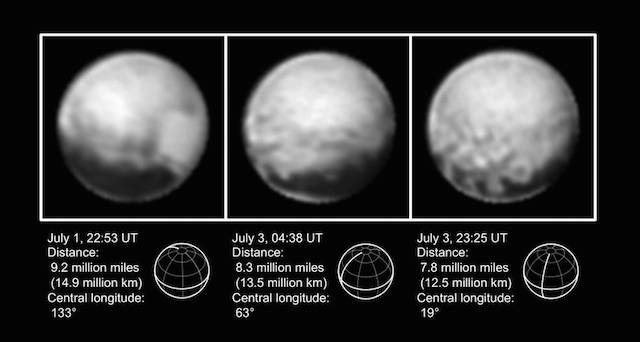
Update from NY Times: message arrived on Tuesday, July 14th. Mission has gone smoothly:
“On schedule, at 8:52:37 p.m. Eastern time, a message from the spacecraft arrived at Mission Control here at the Johns Hopkins Applied Physics Laboratory.
“We are in lock with carrier,” said Alice Bowman, the missions operations manager. “Stand by for telemetry.”
And a few moments later, when she confirmed that data was coming down, cheers erupted on Tuesday for the second time.
NASA’s New Horizons spacecraft is about to glide straight past Pluto and give humans the first ever glimpse of the planet close up. It will be a historic event, and the most fascinating planetary action in 25 years, since NASA showed images of Neptune in 1989.
In the early hours of Monday, July 13th, the spacecraft was just 1 million miles away from Pluto, and with every second that passes New Horizons is speeding closer toward its destination.
New Horizons is using the light of the stars as its map—the spacecraft has two star cameras that capture images and then compare them to an onboard map of 10,000 stars, which determines the path and also ensures the spacecraft is tilted in the right position. Due to all the information that is received, the spacecraft can constantly adjust to ensure it is travelling in the right direction as well as facing the right way to capture the best images.
On Tuesday, July 14th, at approximately 7:49 a.m. EDT, the spacecraft, which has taken over 9 ½ years to travel the 3 billion miles to reach the planet, will pass within 7,767 miles of Pluto to unveil the only images of the dwarf-planet that have ever been projected to earth.
Just fourteen minutes later, the spacecraft will then travel within 17,931 miles of Charon, which is Pluto’s jumbo moon.
NASA’s mission to capture sightings of Pluto is the last in its $700 million quest to explore all the planets within our solar system—the first being Venus, which took place in 1962. The July 14th event also marks the 50th anniversary of the first ever close-passing of Mars by Mariner 4 in 1965.
Pluto is not officially a planet. It is now known as a dwarf, which means it resembles a small planet, but lacks certain technical data to allow it to be classed as one. Pluto was classed as a planet on January 19th, 2006 when New Horizons rocketed from Cape Canaveral, Florida. The relegation came only 7 months after take off and it is still a much debated and passionately argued subject.
Despite this, I have called it a planet in my wording here as it is still known and admired by many as either a planet or dwarf-planet.
Clyde Tombaugh made the discovery of Pluto in 1930, and it is the only planet in our solar system that was discovered by an American. Some of Tombaugh’s ashes were placed on the spacecraft.
Pluto it is approximately two-thirds of the size of earth’s moon.

Since Pluto has been discovered, it has only made it one third of the way around the sun in an orbit that takes 248 years.
The New Horizons spacecraft is travelling toward Pluto at approximately 14 km/s.
Signals from the spacecraft take approximately 4 ½ hours to reach controllers in Maryland, so there will be a delay for all of the images to come through. It will take until October 2016 before all the data has been transmitted to earth.
Pluto cannot be seen with the naked eye. However, it is possible to see it with an amateur telescope. It is the most distant object in our solar system that can be viewed through telescope.
Click here to download a full page PDF printable copy of Pluto’s path from June to December 2015.
Watching the first images captured by the New Horizons spacecraft as it draws closer to Pluto is a once in a lifetime opportunity, and it is incredibly exciting to watch as history takes place.
The countdown of Pluto’s unveiling can be found here.
~
July 12th Daily Briefing for New Horizons/Pluto Mission Pre-Flyby:
NASA’s New Horizons Spacecraft: Seeing Pluto as Never Before:
Author: Alex Myles
Editor: Emily Bartran
Photo: NASA/JHUAPL/SWRI; Kevin Gill/Flickr











Read 1 comment and reply